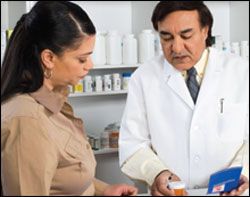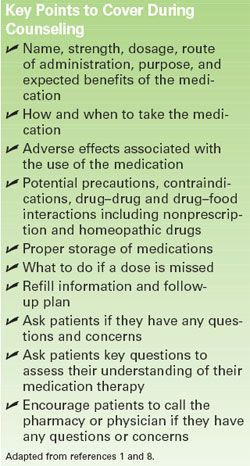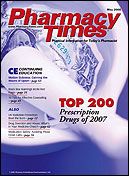Publication
Article
Pharmacy Times
10 Behaviors of Effective Counselors
Author(s):
Studies show that counseling improves patient care and therapeutic outcomes, helping patients to become well informed about the proper use of their medications; several tips for pharmacists are outlined here.
Ms. Terrie is a clinical pharmacy writer based in Haymarket, Virginia.
Pharmacists can have a significant and positive impact on patient care and therapeutic outcomes through effective counseling. The pharmacist?s role is especially important because a patient?s lack of knowledge about his or her medical condition and medications is one factor that may contribute to a patient?s nonadherence to medication regimens and monitoring plans.1

In general, patient counseling has 3 main objectives: assessing the patient?s understanding of the therapy, including proper use and adverse effects of the medication; improving patient adherence; and motivating the patient to take an active role in health management.2 Studies have shown that patient counseling can improve patient care in various ways2:
- Reducing medication errors
- Increasing patients? understanding and management of their medical condition
- Minimizing incidence of adverse drug reactions and drug?drug interactions
- Improving patient outcomes and satisfaction with care
Although every pharmacist implements individualized techniques to counsel patients, various skills are vital to successful pharmacist?patient interaction during patient counseling sessions. Following are 10 features of effective patient counseling:
1. Establish Trust
Pharmacists are among the most accessible and trusted health care professionals. When initiating a patient counseling session, pharmacists should introduce themselves with a brief, friendly greeting to make patients feel comfortable enough to ask questions about their medication therapies and health conditions. Pharmacists who demonstrate a genuine interest in patient care are more likely to encourage dialogue.3
2. Communicate Verbally
Pharmacists can encourage dialogue by asking questions. They should assess what the patient already knows about his or her chosen therapy and tailor the counseling to meet the needs of each individual patient. Ask patients what their physician has told them about the selected therapy and the condition for which they are being treated.
3. Communicate Nonverbally
In addition to verbal communication, it is essential for pharmacists to be aware of nonverbal communication, such as maintaining eye contact with the patient, to demonstrate interest in the information the patient is relaying.4 Pharmacists also should be cognizant of other nonverbal clues, such as facial expressions and tone of voice, when interacting with patients.
4. Listen
When counseling patients about medication therapy, listening to the concerns, questions, and needs of the patient is essential. Listening skills can be categorized into 4 classes: passive listening, acknowledgment responses, encouragement, and active listening.5 Passive listening occurs when the pharmacist enables the patient to communicate without interruption. An acknowledgment response such as nodding occurs during passive listening and alerts the patient that the pharmacist is indeed listening. Pharmacists also can use encouragement strategies through the use of words such as "yes" or "go on." Active listening involves 2- way interactions between the patient and the pharmacist and always should be implemented after passive listening.5
5. Ask Questions
When posing questions to the patient, pharmacists also should state the reason for asking certain questions, so as not to offend the patient.6,7Asking open-ended questions enables pharmacists to gather more information that may lead to other questions and/or provide valuable information to the pharmacist to further assess the patient.
6. Remain Clinically Objective
It is important for pharmacists not to allow personal beliefs?either ethical or religious?to affect their ability to counsel a patient effectively. Pharmacists should make every possible effort to be nonjudgmental and impartial, to focus on patient care, and to maintain a professional demeanor.
7. Show Empathy and Encouragement
When a pharmacist displays empathy and encouragement, a patient may feel more comfortable discussing his or her medical condition and medication use, thus enabling the pharmacist to obtain pertinent information on the patient?s needs and concerns. Emphasizing to patients the importance of adherence to medication regimens can promote positive therapeutic outcomes and motivate patients to take an active role in the management of their health. During counseling, pharmacists also should remind patients to call the pharmacy or their physician with any concerns about their medications.
8. Provide Privacy and Confidentiality
Ensuring complete privacy and confidentiality helps enable patients to feel comfortable discussing personal medical issues. Today many pharmacies are equipped with special counseling areas to address privacy issues. When counseling, pharmacists can reassure patients of privacy by monitoring voice levels and counseling patients away from the dispensing area when possible.
9.Tailor Counseling to Meet Patient Needs
The ability to tailor patient counseling to meet individual needs is critical. Pharmacists should be aware of patients with disabilities and be prepared to treat them with respect and understanding. Techniques should be tailored to accommodate the needs of each patient via verbal counseling or the use of visual aids and demonstrations when warranted. When the medication therapy involves certain administration techniques, such as the use of an inhaler, an injection, or a monitoring device, pharmacists should demonstrate the proper technique to ensure that patients are adequately trained.

10. Motivate Patients
Effective counseling not only provides patients with the pertinent information they need to use their medication correctly, it also motivates them to adhere to their medication regimens. Pharmacists can motivate patients by discussing the benefits of medication adherence, offering support, and explaining the pros and cons of treatment. For example, when counseling a patient with diabetes, in addition to teaching the patient about medications, the pharmacist can stress the importance of maintaining tight glycemic control to decrease or prevent the complications associated with diabetes. Pharmacists also can make suggestions, such as the use of medication reminder containers, to facilitate patient adherence. Information always should be relayed positively, and pharmacists should look continually for ways to inspire patients to learn more about their treatment plan.
Conclusion
During the course of a pharmacist?s busy day, it is impossible to counsel every patient. Whereas the use of written counseling information can be beneficial, it does not replace the interaction between the pharmacist and the patient. Pharmacists should seize every opportunity to counsel patients about their treatment regimens and ensure that patients clearly understand the proper use of their medication. Establishing caring relationships encourages patients to seek counsel, thus increasing the likelihood of positive therapeutic outcomes. Every time a pharmacist takes the opportunity to counsel patients, he or she empowers patients with the information necessary to impact the quality of their health. Although every pharmacist has a different perception of what patient counseling should entail, all pharmacists should strive for one goal when counseling patients: to ensure that patients are well informed about the proper use of their medications.
References
- American Society of Health System Pharmacists (ASHP) Guidelines on Pharmacists-Conducted Patient Education and Counseling.
- Rantucci, M. Pharmacists Talking With Their Patients: A Guide to Patient Counseling. 2nd Edition. Baltimore, MD: Lippincott Williams and Wilkins; 2006:3-4.
- Rantucci, M. Pharmacists Talking With Their Patients: A Guide to Patient Counseling. 2nd Edition. Baltimore, MD: Lippincott Williams and Wilkins; 2006:108-109.
- Rantucci, M. Pharmacists Talking With Their Patients: A Guide to Patient Counseling. 2nd Edition. Baltimore, MD: Lippincott Williams and Wilkins; 2006:158-159.
- Rantucci, M. Pharmacists Talking With Their Patients: A Guide to Patient Counseling. 2nd Edition. Baltimore, MD: Lippincott Williams and Wilkins; 2006:167-168.
- Rantucci, M. Pharmacists Talking With Their Patients: A Guide to Patient Counseling. 2nd Edition. Baltimore, MD: Lippincott Williams and Wilkins; 2006:170.
- Isetts, B, Brown, L. Patient Assessment and Consultation. In: Berardi R, Kroon L, Newton G, et al, eds. Handbook of Nonprescription Drugs. 15th Edition. Washington, DC: American Pharmacists Association; 2006:15-34.
- Rantucci, M. Pharmacists Talking With Their Patients: A Guide to Patient Counseling. 2nd Edition. Baltimore, MD: Lippincott Williams and Wilkins; 2006:70.







